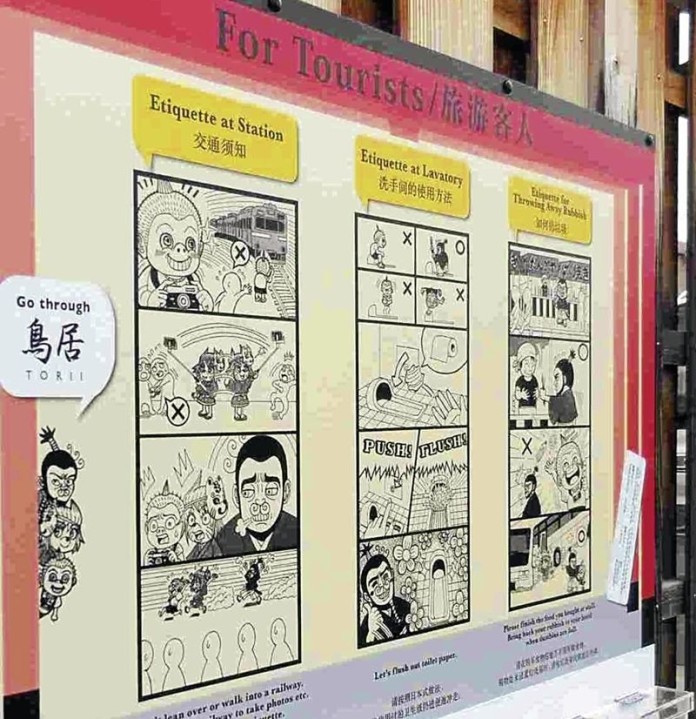With breaches of etiquette by foreign tourists becoming a problem in tourist spots nationwide, local communities are using signboards featuring illustrations, pictograms and manga to inform visitors of how best to behave.
These moves are aimed at helping foreign tourists understand Japanese etiquette and rules, in order to prevent such trouble, but some are concerned that the signs could spoil the scenery at tourist spots.
In three locations that are good for viewing cherry blossoms in Chiyoda Ward, Tokyo, including the Chidorigafuchi moat, signboards were set up this spring for the first time, urging visitors not to break cherry tree branches. Explanations were written in English, Chinese and Korean with a pictogram of a hand trying to hold a tree branch and a line through it.
According to the Chiyoda City Tourism Association, which set up the signboards, it had received complaints from a large number of nearby local residents and Japanese tourists that foreign tourists were breaking the branches of cherry trees. To inform them in an easy-to-understand way that this is a breach of local mores, the association decided to include the illustration on the warning signboards.
Some signboards explain etiquette using manga. Fushimi Ward, Kyoto, set them up in February in a parking area for large buses near the Fushimi Inari Taisha shrine.
Sets of four-frame cartoons warn visitors not to enter the premises to take memorial photos and explain how to use Japanese-style toilets. About 2,000 tourists arrive daily at the parking area. Many of them are with group tours from Asian countries, Europe and the United States.
An official of the ward office expects the signboards to be effective, saying, “We hope visitors will understand the proper etiquette while they’re in the parking area and then go on to enjoy their visit.”
In 2015, the number of foreign tourists to Japan hit a record high of 19.73 million.
The Cabinet Office conducted a survey of 3,000 Japanese nationals nationwide in August last year about the situation involving foreign tourists.
With multiple answers allowed regarding things people are worried about as the number of foreign tourists increases, 26 per cent of respondents cited growing trouble due to differences in etiquette, cultures and customs. This figure was the second highest after the 30 per cent who mentioned security issues.
Match signs to surroundings
Signboards were set up to avoid such trouble, but the signs themselves have also caused concern.
Kyoto’s Gion district is lined by many ochaya tea houses and ryotei Japanese restaurants, and Gionmachi Minamigawa Chiku Kyogikai, an association of local residents in the southern part of the Gion district, set up wooden signboards about two meters tall at four locations there in December last year.
Pictograms and X marks are used instead of letters. They warn against six kinds of prohibited actions, including pulling on the kimono sleeves of maiko and leaning against or sitting on fences.
However, the district is designated by the Kyoto city government as a zone for the maintenance and improvement of historical scenic beauty.
A senior member of the local association said, “We didn’t want to set up the signboards because they impair the scenic beauty, but we could not overlook the breaches of etiquette.”
Seiko Ikeda, a specially assigned professor at St. Agnes’ University, who is studying relations between scenic beauty and signboards in tourist spots, said, “Although I understand the feelings of local residents, I feel uncomfortable about such signboards.”
She added: “Also, in the context of hospitality for foreign tourists, more comprehensive consideration is necessary. For example, such signboards should not bear pictures or designs with aggressive images, and they should harmonize with the surrounding scenery.”
Nobuko Akashi, president of the Japan Manner and Protocol Association, a nonprofit organisation that recommends other measures than signboards, said, “Steady efforts are essential, such as thoroughly notifying visitors about etiquette and rules before they come to Japan via information websites for overseas.”






















